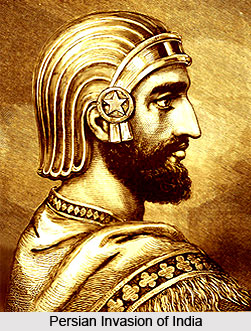 The Persians invaded India by crossing the Hindu Kush mountains in order to get the tribute of the tribes of Gandhara, Kamboja and trans India region. When the Persians possessed north western subcontinent (presently eastern Afghanistan and Pakistan) India supplied mercenaries to the Persian army on order to fight Greeks.
The Persians invaded India by crossing the Hindu Kush mountains in order to get the tribute of the tribes of Gandhara, Kamboja and trans India region. When the Persians possessed north western subcontinent (presently eastern Afghanistan and Pakistan) India supplied mercenaries to the Persian army on order to fight Greeks.
The city of Taxila became a centre of Vedic and Iranian learning. Indian life was highly influenced by the Persian ideas. Persian ascendency in northern India ended with Alexander the Great`s conquest of Persia in 327 BCE. The first political contact between Persia and India was established during the reign of Emperor Cyrus, the founder of the Achaemenid dynasty. Cyrus extended his control up to Indian Ocean. These accounts have been mentioned by writers Herodotus, Ctesias, Xenophon, Strabo and Arrian. Xenophon makes a reference to an Indian ruler sending an embassy of money to Cyrus, probably in payment of tribute. Based on these references it has been believed that Cyrus conquered the frontier regions between India and Persia. According to Ctesias, Cyrus died of a wound inflicted in a battle by `an Indian`. It was a battle in which the Indians were fighting on the side of Derbikes. These Derbikes might have been a frontier tribe.
According to some scholars there was a political control that was established by old Persia on northern India in pre-Achaemenian period. The son and successor of Cyrus, Cambyses (530-522 B.C.) could not pay attention towards India as he was too much pre-occupied by rebellions in his own empire. His son Darius I made decisive conquests in India as his inscriptions speak of Persian dominion in India. The inscriptions at Persopolis and at Naksh-I-Rustam mention the northern Punjab as part of his empire.
According to writer Herodotus India was the twentieth satrapa or province of the Persian Empire. However it is difficult to determine the exact extent of the Persian control over India. The Persian possessions in India comprised the valley of the Indus from Kalabagh to the sea, including the whole of Sind and a considerable portion of the Punjab as well as east of Indus River.
Darius I was succeeded by Xerxes (468-465 B.C.). He continued his hold over Indian provinces as he secured the services of Gandharians and `Indians` to fight his battles against the Greeks. The Persian hold over these Indian regions lasted till 330 B.C. Darius III, the last of the Achaemenian rulers sought reinforcements from India in order to check the progress of Alexander of Macedonia. The Persian Empire under the Achaemenian dynasty came to an end in 330 B.C. when Alexander defeated Darius III in the battle of Arbela.
Effects of Persian Invasion of India
It paved the way for Alexander to conquer India. The political systems of Persia did influence the administration of Mauryan dynasty. The Persians introduced Armanic form of writing.
The satrapa system of administration introduced by the Persians in their Indian provinces served as a model to later dynasties especially the Sakas and the Kushanas.
Development of Trade: The Persian rulers did much to promote geographical exploration and promote trade and commerce. The exploration of the Indus and the Arabian Sea by Scylax opened a new water-route. When the western and north-western India formed parts of the Persian Empire which extended up to Asia Minor in the west, Indian trade got a boost. Indian ivory and teak were popular in markets of Persia.
All the Ashokan rock inscriptions in north-west India were engraved in the Kharoshti script. There is a possibility that this idea of inscribing ethical exhortations on rocks in the form of royal proclamations were borrowed from Persia. There are certain similarities between the Achaemenid inscriptions and those of Ashoka.
Influence on Coinage: The Persian silver coins were circulated in India. These coins were known for their refined minting and elegant looks. The Indian rulers adopted similar techniques to mint their coins on the Persian model.
Impact on Art: The Mauryan rulers adopted certain Persian ceremonies and rituals. Mauryan art was influenced by the Persian art to some extent. One can see traces of the Persian influence in the Mauryan sculptures and in Ashokan pillars. The architecture of the Mauryan period was completely influenced by Persian architecture.



















